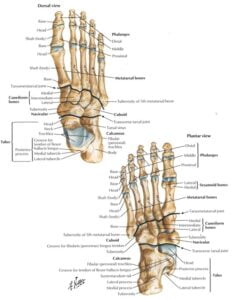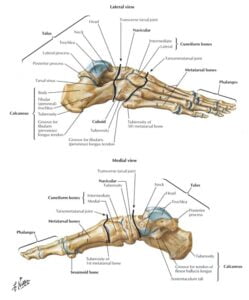The bones of the foot are important for supporting the weight of the body and allowing for movement. There are a total of 26 bones in the foot, which are organized into three main groups: the tarsal bones, the metatarsal bones, and the phalanges.
The tarsal bones are the bones of the ankle and heel. There are seven tarsal bones in the foot, including the:
- Talus: This bone is located in the ankle and forms the joint between the leg and the foot.
- Calcaneus: This bone is located in the heel and forms the base of the ankle joint.
- Navicular: This bone is located near the center of the foot and forms part of the arch.
- Medial cuneiform: This bone is located near the center of the foot and forms part of the arch.
- Intermediate cuneiform: This bone is located near the center of the foot and forms part of the arch.
- Lateral cuneiform: This bone is located near the center of the foot and forms part of the arch.
- Cuboid: This bone is located near the base of the pinky toe and forms part of the arch.
The metatarsal bones are the bones of the toes. There are five metatarsal bones in the foot, one for each toe. The metatarsal bones connect the toes to the tarsal bones and form the structure of the toes.
The phalanges are the bones of the toes. There are 14 phalanges in the foot, with three in each toe (except the big toe, which has two) and two in each big toe. The phalanges form the toes and allow for movement.
It is important to study the bones of the foot in order to understand the structure and function of the foot and to diagnose and treat any problems or injuries that may occur.





